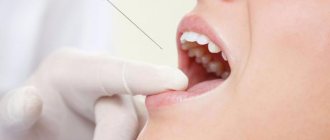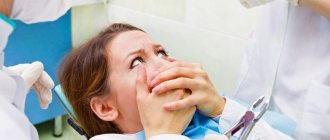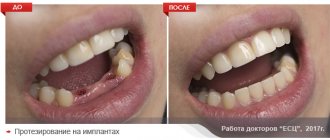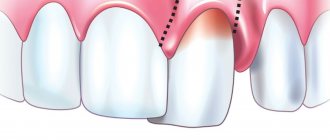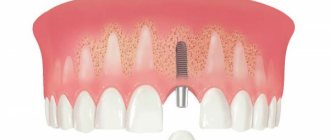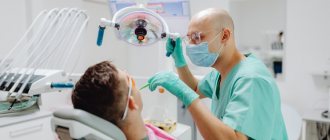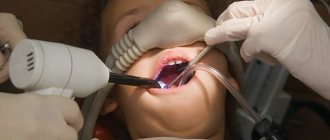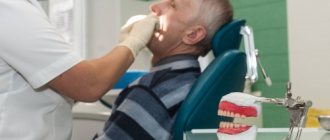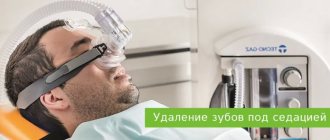Treatment in a dream
What is the advantage of the drug "Sevoran"?
How is treatment performed under Sevoran sedation?
Indications for dental treatment with sedation
When is sedation contraindicated?
A child's trip to the dentist is always stressful. He may be afraid of unfamiliar people, new surroundings, and the need to stay in one position for a long time will simply exhaust him. However, not all parents think about this in time: very often they bring their child to the doctor when there is no longer time to delay and the tooth needs immediate treatment. Such a stressful day can result in psychological trauma for the child.
Sedation can help solve this problem.
- a medical procedure during which a child is put into a state of sleep.
Dental treatment in a dream helps to avoid negative emotions, anxiety and discomfort. In addition, it is completely safe and convenient: while the child is sleeping, the dentist has time to complete the entire scope of work without causing any fear.
In pediatric dentistry "Premiere", a modern inhalation anesthetic "Sevoran" (active ingredient - Sevoflurane) is used for deep sedation for children. This drug has been confirmed to be the safest in the world. It is produced by the famous pharmaceutical company Abbott Laboratories.
Anesthesia in dentistry and its difference from sedation
General anesthesia is an alternative to local anesthesia. It involves completely shutting down a person's consciousness to cause loss of sensitivity during treatment. Dental treatment under anesthesia in adults is usually carried out in cases where it is impossible to use other types of anesthesia. Sometimes they resort to using sedation.
Sedation is often confused with anesthesia, but in fact it is an intermediate link between general anesthesia and dental treatment with anesthesia. In this case, the person is in a state of half-asleep, on the border of sleep and consciousness, while at the same time the contact between the patient and the doctor is maintained.
The similarity between sedation and anesthesia is that they are carried out by an anesthesiologist using the same drugs, but the consequences of sedation are milder, since the dosage is much less.
When general anesthesia is administered, the patient falls into deep sleep. He is unconscious. Dental treatment under anesthesia is rarely practiced, since the number of contraindications and risks of complications in this case exceeds the number of prerequisites for it. If possible, it is better to avoid it, as it has a toxic effect on the human body, especially on the heart, cardiovascular and nervous system. Local anesthesia copes with pain relief no worse, most importantly, without serious consequences.
What to do after tooth extraction?
The following simple recommendations will help to avoid complications after the procedure and will contribute to the speedy healing of the wound that formed at the site of the extracted tooth.
- Minimize all physical stress on the body.
- Do not eat or drink for the first 2 to 3 hours after the procedure.
- Do not eat or drink on the side of the extracted tooth for the first 2 to 3 days.
- Do not brush your teeth for 24 hours after the procedure.
- Do not drink alcohol or tobacco for the first 2 to 3 days after removal.
- Closely monitor your general well-being and sensations in the area of surgical intervention.
Important to remember! Most patients believe that after the intervention the mouth must be rinsed periodically. In fact, this is not necessary, and in most cases it is even harmful. Because frequent rinsing does not allow the wound's blood clot to form normally, which can cause complications or infection. You should especially not abuse this in the first period after surgery.
Subsequently, after the clot is formed, the wound begins to heal, but you cannot fully brush your teeth yet; you can use rinsing as a method of maintaining oral hygiene. You can always find out how to rinse your mouth from your doctor. Usually these are decoctions based on herbs - sage, oak bark, chamomile. In exceptional cases, special pharmaceutical solutions may be recommended.
Indications for treatment under anesthesia
- Dentophobia/stomatophobia (panic fear of dentistry in both children and adults);
- Very low pain threshold;
- Strongly expressed gag reflex;
- Individual intolerance to drugs included in local anesthesia, allergic reactions;
- Mental abnormalities that exclude the possibility of contact between the doctor and the patient, when the patient is unable to adequately respond to the doctor’s actions;
- A large amount of work, or a very long treatment time;
Basic removal steps
Tooth extraction is a rather complex process that should only be performed by specialized dentists.
Important to remember! You should not attempt to remove a diseased tooth yourself. This is fraught with further progression of the disease and complications that will require long-term and expensive treatment.
Typically, surgery includes the following steps:
- taking an x-ray that will help determine the general picture of the condition of the tooth and the topography of its roots;
- collecting the patient’s medical history, which will reveal the presence of allergic reactions and chronic diseases that may be contraindications to the use of anesthesia or removal;
- the use of anesthesia, which allows the removal to be painless for the patient;
- the deletion itself;
- placing a suture on the hole.
On average, the procedure itself takes no more than 20 minutes, during which the patient does not feel pain or severe discomfort.
Contraindications
- Diseases of the cardiovascular system in chronic and acute form;
- Asthma;
- Diabetes;
- Acute myocardial infarction;
- Respiratory tract diseases in the acute stage;
- Mental disorders in the acute stage;
- Acute diseases of the nervous system;
- Pneumonia;
- State of alcoholic intoxication;
- Immunodeficiency conditions;
- Severe kidney and liver diseases;
- Pregnancy.
Online consultation with a doctor
If you are interested in the topic of dental treatment under anesthesia or are already undergoing surgery. When not everything is clear and there are doubts and problems. It is best to undergo an examination and consultation with another dentist. Online communication with a specialist is quite capable of replacing a full-fledged appointment with questions and answers. The doctor will listen, help you decipher the tests, pictures, and give recommendations specifically for your specific situation, taking into account all the information provided to him. This will help you understand the topic sufficiently and calmly and confidently approach treatment using anesthesia.
Disadvantages of general anesthesia (full general anesthesia)
- There may be a possible presence of individual sensitivity to drugs with the effect of reduced or increased sensitivity or long-term aftereffects from anesthesia with deterioration of health (drowsiness, confusion, dizziness, vomiting);
- The need to carry out additional preparatory measures in the form of a general examination , obtaining an ECG 5 hours before the anesthesia procedure is to be performed, avoiding eating three hours before visiting the dentist, and should not consume alcoholic beverages.
- The high speed of work of a dentist in the oral cavity and the associated increased radicalism during manipulations. The doctor’s work time is limited; it is necessary to do all the planned manipulations in the oral cavity; there is not always time for a painstaking search for canals in the roots of the teeth or treatment of teeth in the stage of moderate caries.
- Death of a patient as a result of unexpected general reactions to the administered drug
- To avoid complications of the patient, before performing dental treatment using general anesthesia, it is advisable to examine it in as much detail as possible, especially if you plan to give anesthesia to a child. There is no doubt that these examinations, firstly, sharply reduce the number of patients for whom anesthesia is indicated. After all, if you approach the examination results strictly, many patients will have to be excluded. Secondly, this will lengthen the process of dental treatment; many examination results will have to wait several days from the laboratory. And thirdly, this will further increase the price of the total cost of treatment, which is already quite considerable.
- Such a strict approach is primarily opposed by the patients themselves; few people want to undergo a lot of tests for several days at their own expense; people choose general anesthesia for the sake of speed, in order to cure all their teeth at once.
- However, if unforeseen complications arise, all doctors and patients turn into strict judges and ask with surprise why a detailed examination was not carried out. The truth is that miracles do not happen and any medical intervention has its risks.
- The high cost of general anesthesia is several times higher than the cost of local methods of pain relief due to the need for additional equipment in the clinic and the need to attract an additional anesthesiologist.
- An accompanying person is required to assist a patient after a dental appointment.
Tooth extraction under general anesthesia price, Samara, dental treatment under general anesthesia. Prices for dental treatment under general anesthesia in Samara - price of wisdom teeth removed under general anesthesia where, is it possible to remove teeth under general anesthesia
Immersion of the patient in a state of sleep for 60 minutes allows the following types of work to be performed
- removal of 4-10 teeth (the number depends on the complexity of the procedure);
- removal of 2-4 teeth, characterized by difficult eruption (impacted teeth);
- treatment of 3-5 teeth at the stage of pulpitis (the number is determined by the condition of the roots and canals of the teeth);
- treatment of carious formations up to 5-8;
- installation of dental implants in the required quantity with osteoplasty and sinus lift;
- treatment of periodontitis for up to 3 teeth, depending on the complexity and curvature of the tooth canals.
Teeth under #general anesthesia Samara, wisdom teeth under general anesthesia, #teeth extraction under general anesthesia reviews prices, where to remove teeth under general anesthesia.
Two types of general anesthesia
- Intravenous - injection anesthesia
Today's preference for this option is given by the maximum number of doctors. Special medications that are administered over a specific period of time (the dose is determined by the anesthesiologist).
This method requires appropriate knowledge and experience and can only be performed by a specialist anesthesiologist.
Among the most commonly used drugs are Gekennal, Sombrevin, Calipsool. The patient's condition during the treatment procedure is monitored by an anesthesiologist.
- Inhalation anesthesia
For this type of anesthesia, a special mask is used, through which an anesthetic composition is supplied in a gaseous state - a mixture of gas and oxygen, which enters directly into the respiratory tract, quickly being absorbed into the blood. Nitric oxide, fluorotane, is used as the main anesthetic drug.
Also, during inhalation anesthesia, an intubation tube is used to deliver a general anesthetic.
It is difficult to act as an independent expert in a field of medicine in which you do not practice regularly. However, long experience in surgical dentistry has made it possible to use immersion of patients into medicinal sleep at the reception. At one time, the appointment was carried out at a hospital with the assistance of an anesthesiologist, so it was possible to observe in practice all the features of general anesthesia in dentistry.
First of all, it is necessary to distinguish between premedication drugs and anesthetic drugs. If the first ones can be purchased using a simple recipe. the latter are difficult to acquire, and most importantly, it is difficult to account for their use. The medical institution has many problems with taking them into account; many have seen reports in the press about criminal cases filed against dentists or veterinarians. What should a poor operational worker do if, when checking, he sees that according to the magazine there should be three ampoules of the drug in stock, but there are only two available. In fact, one ampoule went somewhere else, and this is a criminal offense.
Therefore, dentists often use a complex drug mixture for premedication instead of a single drug for general anesthesia. These combinations are officially prescribed in textbooks, they may well be an alternative to general anesthesia, they give almost the same effect. This form of premedication is an excellent solution for a dental appointment, except for two disadvantages.
- Complex combinations of drugs are difficult to control and produce pronounced aftereffects. Most often, they have a strong inhibitory effect and can depress breathing and cardiac activity. Combinations may contain atropine, which is very undesirable.
- The presence in the pharmacopoeia of excellent drugs for raush anesthesia, recommended specifically for short-term outpatient interventions in dentistry, otorhinolaryngology, and gynecology.
An example is midazolam. The drug is little known in Samara, there is almost no experience with its use. Belongs to the group of benzodiazepines, close to tazepam, seduxen. Ultra-fast and ultra-short-acting drug. Provides an excellent level of general immersion with the removal of fear and pain; the patient experiences a superficial pink sleep, allowing the dentist to carry out any intervention slowly and with high quality.
But the main advantage of this drug is that the sleep itself is very superficial, contact with the patient is maintained, the person answers questions, can control his condition and gives signals when it changes, but still sleeps. After completing the treatment, the doctor simply says, “The treatment is over, let’s get up,” and the patient wakes up with a smile. A cup of coffee finally drives away the aftereffect of the drug.
The drug midazolam can be used in tablets and solution; there is no need for intravenous injection. In tablets, the effect occurs within the usual 20 minutes. The uniqueness of the drug is that it can be used intranasally in solution, then the total dose is significantly reduced, and the onset of sleep is sharply accelerated.
But, obviously, today this group of drugs is under very strict control. We do not use strictly controlled drugs, because we are not a hospital and do not have an anesthesiologist on staff.
However, we have a solution for patients with increased fear of visiting the dentist. Oddly enough, you can buy the most powerful sedative drug Novopassit over the counter in a pharmacy. Like any product of the Western pharmaceutical world, it is very widely advertised, freely sold in pharmacies and positioned as a herbal, harmless sedative for daily use. You can take it while driving and give it to children. May be. But it contains the anxiolytic guaifenesin, a very tricky drug. Even 5 years ago, in the instructions for Novopassit (solution) it was clearly called an anxiolytic, and today it is positioned as an expectorant, one of the effects of which is a sedative effect. Thus, it was carefully removed from the list of psychotropic substances and transferred to an expectorant. The calming effect of Novopassit is very strong and is clearly associated not with hop cones and valerian, but with 200 milligrams of guaifenesin in each tablet. By the way, this is a very large dosage for psychotropic substances.
Two such different screenshots.
When taking 2 tablets of Novopassit (as recommended in the instructions) before an appointment with a doctor, the patient receives such a portion of soothing, highly active substances that he laughs merrily in the chair, wondering what funny instruments these dentists have. With a broad gesture, the manufacturer allows you to take 2 tablets 3 times a day, so you can take 2 tablets in advance in the morning so that you are not afraid for sure. The effect of all drugs is very dose dependent.
Good old Corvalol. Many people perceive it as a harmless sedative with a weak effect or as a heart drug for pensioners. In fact, it is a powerful combined sedative that behaves very differently depending on the dose. When taking 10 drops, vasodilating and expectorant properties appear due to the volatility of the valerian and alcohol esters included in its composition. But already after taking 50 drops (recommended in the instructions), the effect of phenobarbital appears, and this is a very strong basic benzodiazepine with a strong sedative effect. The alcohol and valerian ester contained in Corvalol significantly potentiate the effect of the drug. Without violating the instructions, if prescribed by a doctor, you can take 50 drops an hour before your appointment with the dentist and another 50 drops in the dentist’s office; the effect will be quite sufficient to remove the fear of dental treatment. You are strictly forbidden to drive a car; it is advisable to be accompanied by an accompanying person at the reception.
But practice shows that people are not satisfied with simply getting rid of fear and pain. Many people say something like the following - I know that I won’t be hurt or scared at the appointment. I'm scared now when I imagine how scared I will be later. Therefore, I want to know that this “later” will not happen, that I will sleep during the appointment under anesthesia. But this is probably for psychotherapists. As a form of reassurance, I can say that when a patient sees a syringe or a mask for general anesthesia, he immediately remembers all the complications and all the risks, in his eyes there is a frantic horror in front of the darkness of sleep and he is fully aware of the artificiality of his fear of the drill.
Wisdom tooth removal under general anesthesia, wisdom tooth removal under general anesthesia Samara, dental treatment reviews, where teeth are treated under general anesthesia.
Dental treatment.
Are teeth removed under general anesthesia in Samara, can a tooth be treated under general anesthesia, general anesthesia when treating a tooth
How is treatment performed under general anesthesia and its types?
To be able to carry out treatment under general anesthesia and guarantee the safety of patients, a dental clinic must have a number of characteristics, namely:
- Have a license for anesthesiology and resuscitation, as well as the right to use potent drugs;
- Have a staff of anesthesiologists and resuscitators, have all the necessary equipment and equipment;
- Set up a temporary room for the patient until the general anesthesia wears off.
Expert opinion
Emir Romanovich Omerelli
Maxillofacial surgeon, implantologist
Experience: more than 13 years
To exclude the development of complications, before starting treatment it is necessary to conduct a thorough examination: ECG, X-ray of the lungs, consultations, if necessary, with a therapist, cardiologist and other doctors, collection of blood tests. All this is important to fully assess the patient’s condition and select the optimal type and drug of anesthesia.
They are as follows:
- Mask (inhalation), which is carried out by the patient inhaling a mixture of oxygen and anesthetic gases through a mask. This type of anesthesia is often given to children;
- Intravenous. By introducing anesthetic drugs into the blood.
Dental procedures that can be performed under general anesthesia:
- Removal of a tooth cyst;
- Removal of several wisdom teeth;
- Multiple dental implants.
What is the advantage of the drug "Sevoran"?
- The patient falls asleep as soon as he takes a breath.
- The possibility of allergies is excluded.
- No side effects.
- After consuming Sevoran, the child wakes up easily and quickly, and can move independently within 15 minutes.
- All procedures can be performed in one appointment, meaning you can get a healthy smile as quickly as possible.
"Sevoran"
is a certified and licensed medicine that meets all international standards. In Russia it has been used since 2005, and in the USA, Japan and the European Union for the last 22 years. Statistics show that this is the safest drug intended for inhalation anesthesia, and therefore it is ideal for pediatric outpatient dental practice.
Possible complications during general anesthesia
There are many side effects of general anesthesia. Sometimes, even in the absence of contraindications, the body's reaction to an anesthetic can be unpredictable, so anesthesia is always a risk. The following complications may occur:
- Decreased cognitive function of the brain;
- Difficult recovery from anesthesia, prolonged confusion;
- Dizziness;
- Nausea and urge to vomit;
- Strong headache;
- Muscle pain;
- Injury to the oral cavity (tongue, teeth, lips);
- Respiratory tract infection;
- Severe brain damage, death (the percentage of cases is minimal).
Types of tooth extraction
Doctors at the Premier clinic practice all types of removal.
- Removal of the upper tooth;
- Removal of the lower tooth;
- Removal of the 8th tooth – the so-called wisdom tooth;
- Removal of impacted teeth, the eruption of which is difficult;
- Removal of a tooth cyst;
- Removal of nerve and tooth root.
In each specific case, the most suitable method will be selected, which will allow the procedure to be carried out as efficiently as possible and absolutely painless for the patient. The main thing is not to avoid regular visits to the dentist, which should become a good habit for everyone and will help maintain oral health.
Treatment prices
Dental procedures performed under anesthesia are quite expensive. It consists of a consultation with an anesthesiologist, the qualifications of all doctors involved in the process, the type of anesthesia, the drug administered, the prestige of the clinic and is calculated in proportion to the treatment time. In Moscow, treatment under anesthesia will cost from 15,000 rubles per hour. In the regions of Russia the price is lower, ranging from 10,000 rubles per 1 hour.
It is very important to inform patients about all the nuances of treatment using general anesthesia, so that the person can assess the risks and decide whether to undergo treatment under anesthesia or choose safe local anesthesia. Treatment and removal of teeth under anesthesia can really be effective, the main thing is not to forget about the restrictions and contraindications. No dentist can guarantee the absolute success and successful outcome of this method. In addition, careful preparation of the patient for general anesthesia, exclusion of contraindications, and strict adherence to the doctor’s prescriptions are absolutely necessary.
Possible complications after tooth extraction
If you went to a specialized institution and the removal was performed by an experienced dentist, then you don’t have to worry about complications.
The following symptoms are also not cause for concern:
- the presence of slight swelling and bruises in the intervention area, which reach their peak on the third day;
- presence of pain;
- the presence of slight bleeding during the first 2 - 3 hours after the procedure;
- slight increase in body temperature;
- inability to open your mouth wide during the first days;
- dry lips and corners of the mouth.
These phenomena are considered normal and do not require qualified assistance from specialists.
If you experience the following symptoms:
- very severe pain that cannot be relieved with painkillers;
- bleeding that lasts more than 12 hours;
- numbness of the jaw that does not go away within 2 days after the removal procedure;
- very severe swelling or tumor formation after removal, making swallowing and speech difficult;
- an increase in body temperature to 380C or more, which lasts for several days.
In each of these cases, you must immediately seek help from a doctor, which will help avoid the development of complications.
